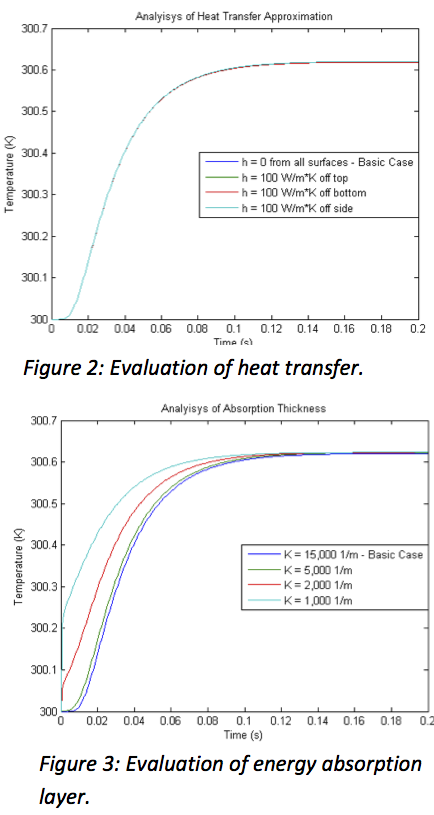Trevor Terrill and Dr. Matthew Jones, Department of Mechanical Engineering
Project Overview
The purpose of this project was to conduct a rigorous investigation of each of the approximations made in the development of the pulsed laser method for measuring the thermal diffusivity. Thermal conductivity is an important engineering parameter, but measuring it directly is difficult. In common engineering practice, the thermal diffusivity, specific heat, and density are measured, and the thermal conductivity is calculated from these properties. The pulsed laser or flash method is commonly employed to measure the thermal diffusivity, but it contains many restrictive approximations that are difficult to satisfy in practice. This project investigated the significance of each of these approximations by quantifying the error in relaxing each of the approximations.
Project Results
After developing a model in two software packages, FLUENT and Finite Element Heat Transfer (FEHT), each approximation used in the flash method was relaxed one at a time and the influence of each approximation was assessed. Knowledge of which approximations are significant in evaluation of the thermal diffusivity is assisting in the development of a second generation, robust model for extracting the thermal diffusivity from realistically obtained data. After a preliminary study using FEHT, a more sophisticated program, FLUENT, was used to rigorously investigate the approximations. Using this more sophisticated model, the following approximations from the pulsed laser method were evaluated:
- No heat transfer from the surfaces
- Energy absorbed in a very thin layer
- Energy absorbed in a short time
- One dimensional heat flow
The heat generation term in the FLUENT model is based on the equation seen in Figure 1. This equation allows investigation of Approximations 2-4, with Approximation 1 being varied in the FLUENT model itself. When large values of K, small pulse times, and large values of r are chosen in the equation, approximations 2-4 are satisfied, respectively.
The model was created and all approximations were satisfied to verify that the system did indeed reflect the Parker laser pulse model. The simulated model in FLUENT matches almost exactly the temperature profile obtained from the Parker model. By ensuring the accuracy of the initial reference case, confidence is insured when analyzing the relaxation of the approximations.
This model incorporated conditions typically seen in an actual system and was a good indication of realistic conditions. Systematically evaluating each of the approximations, it was discovered that the thickness of the layer of energy absorbed, the length of the energy absorption, and the multi-dimensional heat flow all lead to significant error when the approximations are relaxed. Consequently, satisfying these approximations is necessary to obtain accurate results in the laser pulse method. In contrast, heat transfer from the sample had no measurable effect on the results. Relaxation of this approximation introduced no additional error into the diffusivity calculations.
Heat Transfer from Surfaces
A convection coefficient was introduced to simulate heat transfer by means of convection from the surface. Values were chosen to represent natural convection, the principle mode of heat transfer in the system. At values of h, the convection coefficient, approaching the reasonable maximum for natural convection, there is no noticeable deviation of the temperature profile from the reference case. (Seen in Figure 2) Additionally, there was no change in the calculated diffusivity and associated error in any of the tested cases. It can be deducted that the heat transfer approximation is insignificant in the realm of natural convection.
Other Varied Approximations
This study revealed that all other relaxed approximations resulted in significant error and markedly different temperature profiles. An example of this is seen in Figure 3. As the layer in which energy absorbed was increased, the temperature profile deviated from the Parker model, and the resulting error was significant.
Conclusion and Project Benefits
This project revealed the necessity of satisfying the majority of the established approximations for the laser flash method of measuring thermal diffusivity. With the exception of heat transfer by means of natural convection, all of the relaxed approximations introduced significant error into the resulting diffusivity calculations. Since these approximations are difficult to satisfy in practice, a more robust model is required to make accurate diffusivity measurements based on realistic experimental conditions. A more robust, second generation analytical model for measuring the thermal diffusivity is currently under development. The model developed in FLUENT is currently being used to validate this accurate and robust algorithm for extracting values of the thermal diffusivity from data realistically obtainable using a pulsed laser diffusivity measurement system. This project has taught me use of valuable software tools such as FLUENT. I have also been able to learn crucial skills in research method and written communication.

